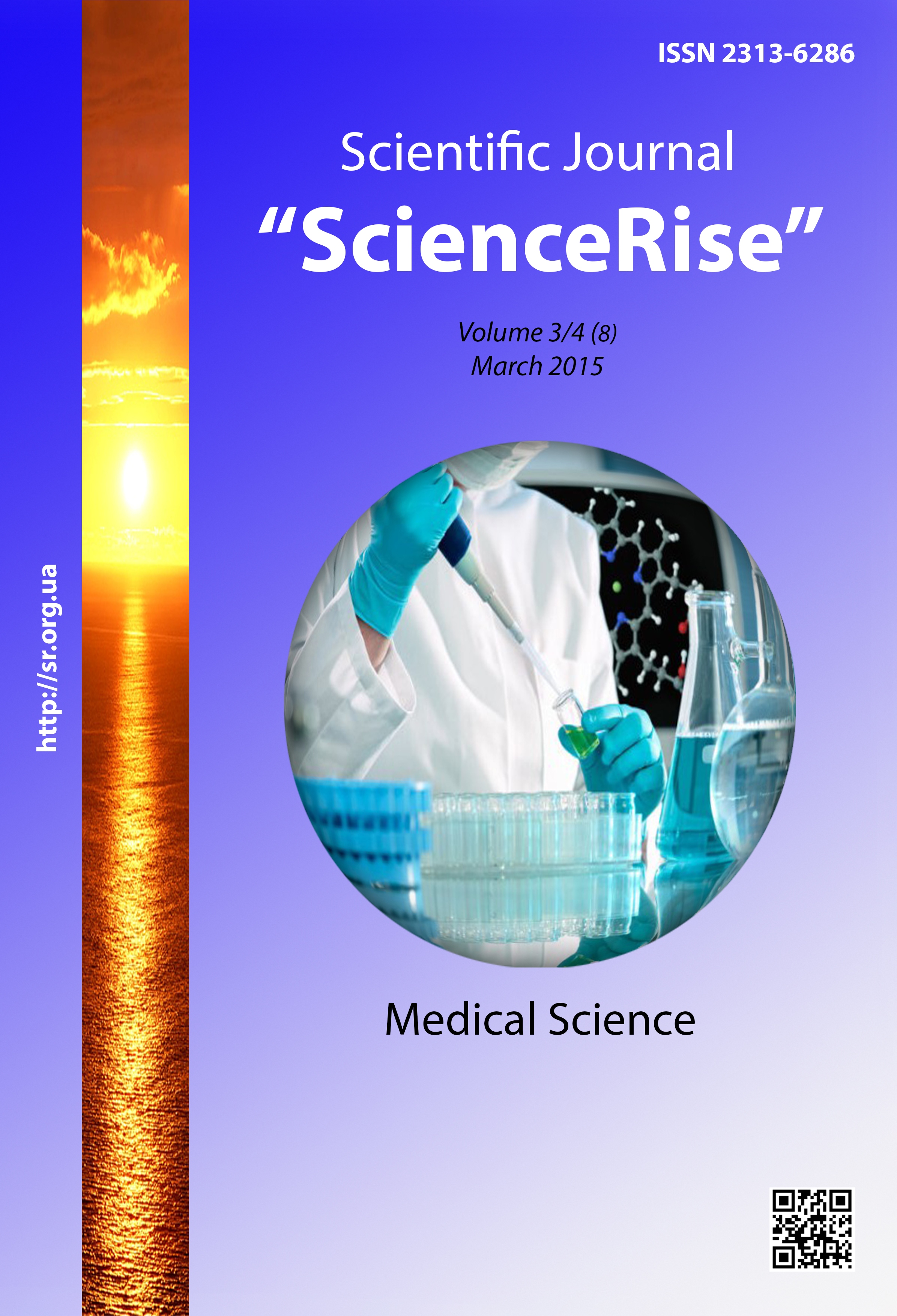Features of the heart rate variability in the perioperative period after adenotomy in children
DOI:
https://doi.org/10.15587/2313-8416.2015.39181Keywords:
adenotomy, intravenous anesthesia, inhalation anesthesia, heart rate variability, painAbstract
Aim. Study course of perioperative period after adenotomy in children in different ways of general anesthesia by examining indicators of heart rate variability and efficacy of postoperative analgesia.
Materials and methods. To study included 70 children aged from 6 to 8 years, which was held adenotomy. Patients were divided into 3 groups: group I (n = 28) - operated under conditions of intravenous anesthesia based on propofol combined with fentanyl; group II (n=23) – operated under conditions of inhalation anesthesia by sevoflurane in combination with fentanyl and analginum; group III (n=19) – operated under conditions of intravenous anesthesia based on thiopental sodium combined with fentanyl. Differences were considered significant at p <0.05 using Student t-test.
Results. Indicators of heart rate variability indicated that in the extubation stage in all groups of patients revealed high activity of the sympathetic tone with the trend of decline in the morning after surgery. Statistically higher activity of the sympathetic part of the autonomic nervous system was in patients of group III - 1 hour after surgery compared with patients groups I and II (p <0,001 and p <0,01, respectively). After 1 hour after surgery on the scales "Faces" and "Oucher" scores indicated that the child "a little hurt" in all groups of patients In the dynamics of observation in all groups tended to reduce the intensity of pain. An interpretation of scores on the FLACC scale indicated that patients in both groups felt comfortable.
Conclusions. It was found that in patients in all groups there are changes in the nervous regulation of heart rate variability, characterized by increased activity of the sympathetic division of the autonomic nervous system. Postoperative anesthesia by 10 mg / kg ibuprofen provides effective analgesia
References
Baevskij, R. M. (2004). Analiz variabel'nosti serdechnogo ritma: istorija i filosofija, teorija i praktika [Analysis of the heart rate variability: the history and philosophy, theory and practice]. Klinicheskaja informatika i telemedicina, 1, 54–64.
Pediatric Pain Management. Available at: http://www.emoryhealthcare.org/saint-josephs-hospital-atlanta/health professionals/cme/pdf/ama_painmgmt_m6 2010.pdf
Zil'ber, A. P. (1994). Klinicheskaja fiziologija v anesteziologii i reanimatologii [Clinical physiology in anesthesiology and intensive care]. Moscow, Russia: Medicina, 113–124.
Rjabov, G. A. (1994). Sindromy kriticheskih sostojanij [Syndromes of critical states]. Moscow, Russia: Medicina, 84–105, 175–194.
Reis, F. M., Ribeiro-de-Oliveira, A. Jr., Machado, L., Guerra, R. M., Reis, A. M., Coimbra, C. C. (2008). Izmenenija prolaktina i gljukozy v plazme, inducirovannye hirurgicheskim stressom: edinaja ili dvojstvennaja reakcija? [Plasma prolactin and glucose alterations induced by surgical stress: a single or dual response?] Mini-review (Perevod i obrabotka V. Fesenko). Medicina neotlozhnyh sostojanij, 5 (18), 108–114.
Chumbley, G. M., Hall, G. M. (1997). Recovery after major surgery: does the anesthetic make any difference? British Journal of Anaesthesia, 78 (4), 347–349. doi: 10.1093/bja/78.4.347
Golub, I. E., Sorokina, L. V. (2005). Hirurgicheskij stress i obezbolivanie: monografija [Surgical stress and pain relief: a monograph]. 2-nd edition. Irkutsk, Russia, 201.
Taylor, L. K., Auchus, R. J., Baskin, L. S., Miller, W. L. (2013). Cortisol response to operative stress with anesthesia in healthy children. The Journal of Clinical Endocrinology & Metabolism, 98 (9), 3687–3693. doi: 10.1210/jc.2013-2148
Traynor, C., Hall, G. M. (1981). Endocrine and metabolic changes during surgery: anaesthetic implications. British Journal of Anaesthesia, 53 (2), 153–160. doi: 10.1093/bja/53.2.153
Baevskij, R. M., Ivanov, G. G., Chirejkin, L. V. (2001). Analiz variabel'nosti serdechnogo ritma pri ispol'zovanii razlichnyh jelektrokardiograficheskih sistem (metodicheskie rekomendacii) [Analysis of the heart rate variability using different electrocardiographic systems (guidelines)]. Vestnik aritmologii, 24, 66–85.
Haspekova, N. B. (2003). Diagnosticheskaja informativnost' monitorirovanija variabel'nosti ritma serdca [Diagnostic informativity during monitoring of the heart rate variability]. Vestnik aritmologii, 32, 15–27.
Olsson, E. (2010). Heart Rate Variability in Stress-related Fatigue, Adolescent Anxiety and Depression and its Connection to Lifestyle. Digital Comprehensive Summaries of Uppsala Dissertations from the Faculty of Social Sciences. Acta Universtatis Upsaliensis, 66.
Makarov, L. M. (2003). Holterovskoe monitorirovanie [Holter monitoring]. 2-nd ed. Moscow, Russia: Medpraktika-M, 340.
Association of Paediatric Anaesthetists of Great Britain and Ireland. (2012). Good practice in postoperative and procedural pain management, 2nd edition. Paediatr Anaesth, 22, 1–79. doi: 10.1111/j.1460-9592.2012.03838.x
Tomlinson, D., von Baeyer, C. L., Stinson, J. N., Sung, L. A. (2010). A systematic review of faces scales for the self-report of pain intensity in children. Pediatrics, 126 (5), 1168–1198. doi: 10.1542/peds.2010-1609
Downloads
Published
Issue
Section
License
Copyright (c) 2015 Михайло Борисович Пушкар

This work is licensed under a Creative Commons Attribution 4.0 International License.
Our journal abides by the Creative Commons CC BY copyright rights and permissions for open access journals.
Authors, who are published in this journal, agree to the following conditions:
1. The authors reserve the right to authorship of the work and pass the first publication right of this work to the journal under the terms of a Creative Commons CC BY, which allows others to freely distribute the published research with the obligatory reference to the authors of the original work and the first publication of the work in this journal.
2. The authors have the right to conclude separate supplement agreements that relate to non-exclusive work distribution in the form in which it has been published by the journal (for example, to upload the work to the online storage of the journal or publish it as part of a monograph), provided that the reference to the first publication of the work in this journal is included.

